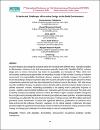Criteria and Challenges of Inclusive Design in the Built Environment

View/
Date
2023Author
Abdelkarim , Shimaa BasheirAhmad, Ahmad Mohammed
Zahrah, Janet
Makhoul, Nancy Nabil
Al-Nuaimi, Maryam Nasser
Naji, Khalid
...show more authors ...show less authors
Metadata
Show full item recordAbstract
Inclusive design is about designing accessible spaces for individuals with different needs. It beholds the ability to affect people's behaviour in the built environment, especially People With Disability (PWDs). Inclusive design aims to remove the barriers that hinder the accessibility and interaction of PWDs within their surroundings, enabling equal opportunities and expanding the scope of their activities. Ensuring an inclusive environment is the responsibility of architects, planners, engineers and facility managers. It is essential to ensure that buildings' design and operation align with inclusive principles through regular assessments. Many comprehensive assessment tools have been developed by scholars and used in the industry. Still, when issues arise like insufficient funding, the decision-makers should be able to prioritize inclusive design criteria in a defined assessment checklist. Addressing accessibility at the building level is particularly important to provide a suitable environment that facilitates users' interaction with the built environment. This study aims to identify prioritized accessibility assessment criteria for PWDs in higher education facilities through the lens of experts and to provide justifications for selecting the highest and lowest priorities. A targeted sampling methodology was adopted for the semi-structured interviews. Findings include a list of the highest and lowest prioritized criteria, identification of criteria with significant differences, justifications for selections and a close-up look into the influence of experts' experience on the criteria rankings. Furthermore, this paper provides insight into significant inclusive design criteria for improved FM decision-making processes and the strategy for managing the challenges of inclusive design in new and existing facilities.
DOI/handle
http://hdl.handle.net/10576/47045Collections
- Architecture & Urban Planning [308 items ]
- Civil and Environmental Engineering [862 items ]
- Theme 1: Contemporary issues in Construction Engineering and Management [39 items ]

